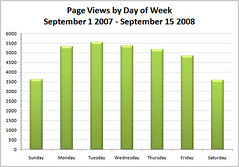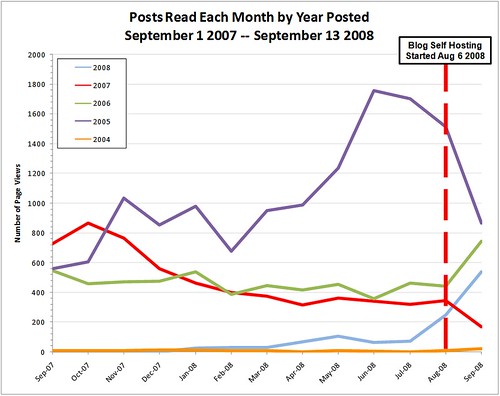This week, I have been discussing the different approaches to blog analytics that can be used to determine what posts from a blog’s archive are most popular, and whether a blog is front-loaded or long-tailed. The thesis is that it’s not always what the words in the blog are that are important.
In a guest post this morning at ProBlogger, Skellie discusses how the value of social media visitors is different and inherently more complex than the value of visitors generated from traditional methods, such as search and feedreaders. Her eight points further support my ideas that the old advertising models are not the best suited for the new blogging world.
Stepping away from the existing advertising models that have been used since blogging popularity exploded in 2005 and 2006, it is clear that the new, interactive social web model requires an advertising approach that centers on community and conversation, rather than the older idea of context and aggregated readership.
The Current Model
Current blog advertising falls into two categories:
- Contextual Ads. This is the Google model, and is based on the ad network auctioning off keywords and phrases to advertisers for the privilege of seeing their ad links or images appear on pages that contain those words or phrases.
- Sponsored Ads. Once a blog is popular enough and can prove a well-developed audience, the blogger can offer to sell space on his blog to advertisers who wish to have their products, offerings or companies presented to the target audience.
In my opinion, these two approaches fail blog owners.
Contextual ads understand the content of the page, but do not understand the popularity of the page, or its relationship to the popularity of other pages in the archive.Contextual ads lack a sense of community, a sense of conversation. While the model has proven successful, it does not maximize the reach that a blog has with its own audience.
Sponsored ads understand the audience that the blog reaches, but do not account for posts that draw the readers’ attention for the longest time, both in terms of time spent reading and thinking about the post as well as over time in an historical sense. The sponsored ad model assumes that all posts get equal attention, or drive community and conversation to the same degree.
The New Model
In the new model, more effective use of visitor analytics is vital to shaping the type and value of the ads sold. Studying the visitor statistics of a blog will allow the owners to see whether the blog is, in general, front-loaded or long-tailed.
If the blog has a front-loaded audience, the most recent posts are of higher value and could be auctioned of at higher prices. In order for this to work, both the ad-hoster and the advertiser would have to agree to the value of the most recent posts using a proven and open statistical analysis methodology. In the case of front-loaded blogs, this analysis methodology would have to demonstrate that there is a higher traffic volume for posts that are between 0-3 days old (setting a hypothetical boundary on front-loading).
For blogs that are long-tailed, those posts that continue to draw consistent traffic would be valued far more highly than those that fall out into the general ebb and flow of a bloggers traffic. These posts have proven historically that they appear highly in search results and are visited often.
In addition to the posts themselves, the comment stream has to be considered. Posts that generate an active conversation are farmore valuable those that don’t. Again, showing the value of the conversation is reliant of the ability to track the numbers of people in the conversation (through Disqus or some other commenting system).
This model can be further augmented by using a tool like Lookery that helps to clearly establish the demographics of the blog audience. Being able to pinpoint not only where on a blog to advertise but also who the visitors are who view those page, provides a further selling point for this new model and helps build faith in the virtues of a blog that sells space using this new, more effectively targeted advertising pricing structure.
Now, I separate the front-loaded and long-tailed blogs as if they are distinct.
Obviously these categories apply to nearly every blog as there are new posts that suddenly capture the imagination of an audience, and there are older posts that continue to provide specific information that draws a steady stream of traffic to them.
Summary
This is a very early stage idea, one that has no code or methodology to support it. However, I believe that the current contextual advertising model, one based solely on the content of the post, is not allowing the content creators and blog entities to take advantage of their most valuable resource – their own posts and the conversations that they create.
I also believe that blog owners are not taking advantage of their own best resource, Web analytics, to help determine the price for advertising of their site. Not all blog posts are created or read equally. Being able to very clearly show what drives the most eyeballs to your site is a selling point that can be used in a variable-price advertising model.
By providing tools to blog owners that intimately link the analytics they already gather and the advertising space they have to sell, a new advertising model can arise, one that is uniquely suited to the new Web. This advertising model will be founded in the concepts of conversation and community, providing more discretely targeted eyeballs to advertisers, and higher ad revenues to blog owners and content creators.
UPDATES
Appears that BuzzLogic has already started down this path. VentureBeat has commentary here.




